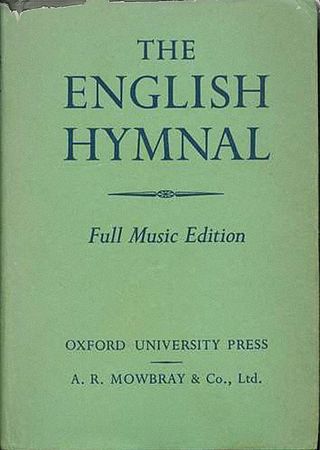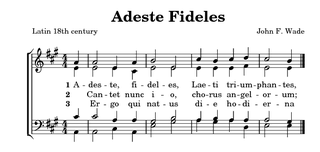
A hymn is a type of song, and partially synonymous with devotional song, specifically written for the purpose of adoration or prayer, and typically addressed to a deity or deities, or to a prominent figure or personification. The word hymn derives from Greek ὕμνος (hymnos), which means "a song of praise". A writer of hymns is known as a hymnist. The singing or composition of hymns is called hymnody. Collections of hymns are known as hymnals or hymn books. Hymns may or may not include instrumental accompaniment. Polyhymnia is the Greco/Roman goddess of hymns.

A hymnal or hymnary is a collection of hymns, usually in the form of a book, called a hymnbook. They are used in congregational singing. A hymnal may contain only hymn texts ; written melodies are extra, and more recently harmony parts have also been provided.
The Three-Self Patriotic Movement is the official government supervisory organ for Protestantism in the People's Republic of China. It is colloquially known as the Three-Self Church.

The China Christian Council was founded in 1980 as an umbrella organization for all Protestant churches in the People's Republic of China with Bishop K. H. Ting as its president. It works to provide theological education and the publication of Bibles, hymnals, and other religious literature. It encourages the exchange of information among local churches in evangelism, pastoral work and administration. It has formulated a church order for local churches, and seeks to continue to develop friendly relations with churches overseas.

A metrical psalter is a kind of Bible translation: a book containing a verse translation of all or part of the Book of Psalms in vernacular poetry, meant to be sung as hymns in a church. Some metrical psalters include melodies or harmonisations. The composition of metrical psalters was a large enterprise of the Protestant Reformation, especially in its Calvinist manifestation.

The English Hymnal is a hymn book which was published in 1906 for the Church of England by Oxford University Press. It was edited by the clergyman and writer Percy Dearmer and the composer and music historian Ralph Vaughan Williams, and was a significant publication in the history of Anglican church music.
Kingdom songs are the hymns sung by Jehovah's Witnesses at their religious meetings. Since 1879, the Watch Tower Society has published hymnal lyrics; by the 1920s they had published hundreds of adapted and original songs, and by the 1930s they referred to these as "Kingdom songs" in reference to God's Kingdom.
The Chinese Union Version (CUV) is the predominant translation of the Bible into Chinese used by Chinese Protestants, first published in 1919. The text is now available online.
Hymns are an important part of the history and worship of the Church of Jesus Christ of Latter-day Saints.

A hymn tune is the melody of a musical composition to which a hymn text is sung. Musically speaking, a hymn is generally understood to have four-part harmony, a fast harmonic rhythm, with or without refrain or chorus.
The Bible has been translated into many of the languages of China besides Chinese. These include major minority languages with their own literary history, including Korean, Mongolian, Tibetan, Kazakh, Kyrgyz, Russian and Uyghur. The other languages of China are mainly tribal languages, mainly spoken in Yunnan in Southwest China.
The earliest Christadelphian hymn book published was the "Sacred Melodist" which was published by Benjamin Wilson in Geneva, Illinois in 1860. The next was the hymn book published for the use of Baptised Believers in the Kingdom of God by George Dowie in Edinburgh in 1864. "The Golden Harp" was put together in 1864 by Scotsman Robert Roberts.

Canaan Hymns or Songs of Canaan is a collection of Chinese hymns composed by Lü Xiaomin, a Christian convert peasant woman with no musical education, beginning in 1990. Lü's theological background is in Pentecostalism and the local churches movement, and the hymns reflect themes of Christology, pneumatology and eschatology against the backdrop of Chinese political realities.
Hymns of Universal Praise, a Chinese hymnal published in 1936, is considered to be an ecumenical attempt at Chinese hymnology from the early twentieth century. According to the Hong Kong hymnologist Andrew Leung, the first edition, HUP1936, established the foundation of Chinese hymnody and is now set as a model of Chinese hymnology.
Hymnody in continental Europe developed from early liturgical music, especially Gregorian chant. Music became more complicated as embellishments and variations were added, along with influences from secular music. Although vernacular leisen and vernacular or mixed-language carols were sung in the Middle Ages, more vernacular hymnody emerged during the Protestant Reformation, although ecclesiastical Latin continued to be used after the Reformation. Since then, developments have shifted between isorhythmic, homorhythmic, and more rounded musical forms with some lilting. Theological underpinnings influenced the narrative point of view used, with Pietism especially encouraging the use of the first person singular. In the last several centuries, many songs from Evangelicalism have been translated from English into German.
Lin Shengben is a Chinese hymn composer, known for his songs composed with Chinese traditional tunes.
Church music during the Reformation developed during the Protestant Reformation in two schools of thought, the regulative and normative principles of worship, based on reformers John Calvin and Martin Luther. They derived their concepts in response to the Catholic church music, which they found distracting and too ornate. Both principles also pursued use of the native tongue, either alongside or in place of liturgical Latin.
Lü Xiaomin or Ruth Lu is the author of over 1,800 Canaan Hymns, popular among churches in China today.







